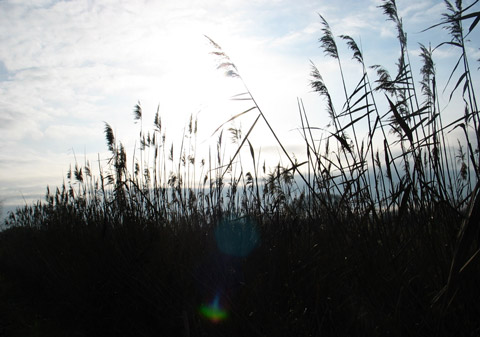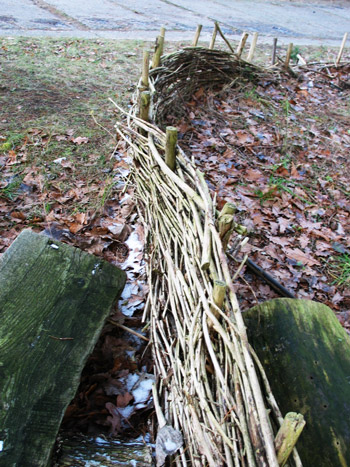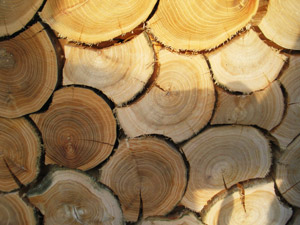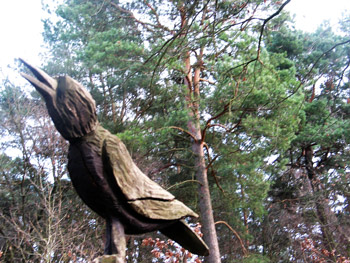Protecting the Nature of East Berlin

Herr H takes an A3-sized photograph out of his bag and holds it up proudly for us to see. On the photograph, an aerial view of the wooden chalet, lush vegetation, natural pine trees and rough grassland, of the Kaniswall Freiland Labor, or ‘open-air laboratory’, is framed by straight irrigation ditches and a narrow, winding River Spree. Captured in blazing sunlight, and surrounded by empty fields, Kaniswall is a tempting glimpse of nature, as it was meant to be, within spitting distance of the German capital.
“It was a chance to do something, and we took it†Herr H explains. Back in 1991, when he founded the ‘Green Learning Space’ at Kaniswall, the Berlin wall had just fallen. A Stasi holiday complex was being torn down, and there it was – Herr H’s chance.
Our tour of the ‘open-air laboratory’ begins in the classrooms and activity rooms of the facility. In the first, we stumble upon a group of 10 year-olds baking and decorating Christmas cookies. There is a family of iguanas in a tank in the corner, microscopes are piled in the cupboards and a long table for examining water specimens stands in the centre of the room.
There are almost as many adults as children present and the atmosphere is one of a pre-Christmas treat. One of the adults spots my recording device. She tells me there’s a child from her class in the other room who can “talk wellâ€, and duly goes off to get him. His name is Justin, and he tells me at a high rate of words per minute that he has just been learning about how various animals survive the winter. Herr H and I follow him back into a darkened classroom where a student volunteer is showing slides. “I didn’t know butterflies hibernated!†I whisper to Herr H, as he points me towards the gorgeous posters of plant life which cover the walls.

In the next classroom some 12 year olds are piecing together a tree-trunk jigsaw puzzle in a corner. One of them tells me it’s his sixth time here. They come from a school in Marzahn, a district leading east out of the city which was built up in 1977 as a model communist-era housing project. The street-length, gray tower blocks were each painted with a different animal motif over the entrance, so that children returning from school would know which one was home. These days it is a district foreigners are advised to avoid.
We continue our tour past an exhibition on genetics on permanent loan from Switzerland. The stiff boards with their printed information are a contrast to the touchy-feely relationship to nature evident elsewhere at the Kaniswall. On the other side of the room a couple of wild boar skins catch my eye, draped over a large log. I run my fingers through the straw-like hair of one of the skins, which includes the whole of the pig’s furry face, with holes where the eyes once looked out.
Next comes the hay room. The wooden floorboards and walls are lined with hay bales and straw, filling our nostrils with a sweet, dry warmth. Herr H tells me this is in part due to the Heilkräuter, the healing natural herbs dried along with this “certified organic hayâ€, as he puts it. There are some mats on the cushioned floor and the ceiling is decorated with little glow-in-the-dark stars arranged in the form of the main constellations.
We make a very enjoyable tour of the outside grounds, including a bat cave in the cellar of a long-gone fisherman’s cottage, a tree nursery and a weather station which sends automatic data readings to the German Meteorological Service in Offenbach am Main. The evening sun reaches out solitary beams over the flat grasslands, captured here and there in the nook of a tree branch or between swaying reeds. We pass through an area of brush grass and bare Robinia saplings.
 This field is not yet protected by law Herr H tells me, they’ll have to wait until 2012. He looks around in irritation at the proliferation of trees and shoots. It seems to have settled in nicely. These Robinia, he says, are neophytes. They don’t belong here. They adapt quickly to the conditions we have, and then they take over. Native to North America, Robinia pseudoacacia, or Black Locust was introduced to Europe in 1601, almost two decades before the Plymouth colonists arrived in Massachusetts. There was a time when adapting quickly and taking over was seen as a good thing. “Competition always results in a loss, in the end, though,†explains Herr H. “Competition just isn’t in our nature.â€
This field is not yet protected by law Herr H tells me, they’ll have to wait until 2012. He looks around in irritation at the proliferation of trees and shoots. It seems to have settled in nicely. These Robinia, he says, are neophytes. They don’t belong here. They adapt quickly to the conditions we have, and then they take over. Native to North America, Robinia pseudoacacia, or Black Locust was introduced to Europe in 1601, almost two decades before the Plymouth colonists arrived in Massachusetts. There was a time when adapting quickly and taking over was seen as a good thing. “Competition always results in a loss, in the end, though,†explains Herr H. “Competition just isn’t in our nature.â€
Herr H has further, as yet tentative plans to continue the march of nature at the Kaniswall. He would like to recreate the original flood plain, filling in the artificial drainage ditches which made it fit for agriculture, and replacing them with the myriad of winding channels by which the River Spree used to make its way westwards, criss-crossing the fields as it flowed. It’s a project that would take the landscape back to that of a 1922 pre-war photograph hanging in a series which Herr H shows me in one of the classrooms. But rivers and rivulets are not static. And when they flow, they don’t choose their path in terms of the benefits to the surrounding natural habitat, or even necessarily because that is the way they have flowed before. The channels carved out by the water reflect purely and simply the path of least resistance – it flows where it is easiest to do so. Over the centuries mankind has created major engineering-intensive solutions to try to control this most basic nature of water. The results have been aqueducts, dams and watergates and have given rise to such things as the marvellously complicated ship’s hoist. And still water will not flow uphill.

Driving back towards Schmöckwitz we cross endless small bridges and pass the watergate at Miersdorf, and the holiday camp in the woods opposite Schmöckwitz Island. I try to quiz Herr H about what changes he has seen in the area since the Wende*. He is unforthcoming, so I eventually change the subject. In an area where everything, especially change, is so political, I can understand if it seems an odd topic for small talk. As I get out of the car and thank him, we discover our gardens face each other on opposite sides of the lake, and we promise to wave next time we see each other over the water.
*the Wende (literally: turning point) is a German term for the fall of the Berlin wall.
Photo credits: Fiona Mizani

